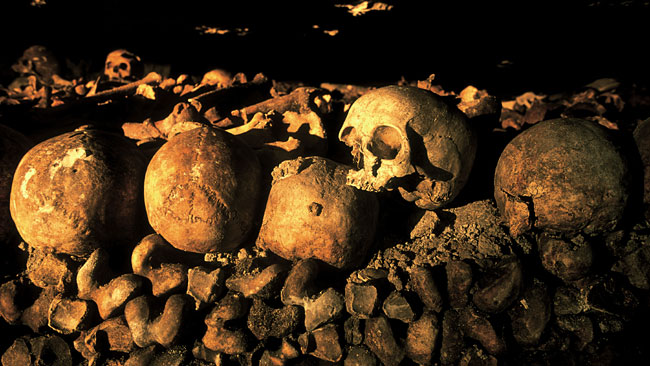Empire of the dead under Paris streets
PARIS has dark and fascinating history under the streets in its catacombs: Jenny Stevens explores.

EVERY city has its dark side.
A fascination with the macabre draws tourists like moths to a flame in Dublin for Bram Stoker's Dracula Experience; to the London Dungeon for its assorted horrors; and to St Petersburg's Kunstkammar for Peter the Great's grisly collection of anatomical specimens.
Even Paris, the City of Light, has a fascination with the dark side, as its most famous cemetery, Pere Lachaise, is firmly on the dead famous tourist trail.
But there's a macabre underbelly to Paris that is rarely exposed. These are the ossuaries, or catacombs, a maze of subterranean tunnels 20m below the streets of the Left Bank's Place Denfert-Rochereau in the 14th arrondissement.
Today they hold the bones of around six million Parisians transported to the catacombs when the old cemeteries were overwhelmed.
Above ground there is little evidence that you are about to enter the underworld.
All you see are people hurrying off to work; students having a last coffee in the cafes before ambling off to university classes; and the traffic swirling around the entrance, an innocuous metal building on a large traffic island that looks like a public toilet.
The discreet sign tells you otherwise: "The ossuary tour could make a strong impression on children and people of nervous disposition," it warns, adding "no smoking, no dogs (only in Paris!), no touching".
This just made the high school students in front of us, who'd obviously grown up on a diet of horror movies, even more excited.
Ignoring signs pleading for the living to respect the dead, they poured down the winding 130 stairs and through the burial chambers like scarab beetles in The Mummy, chattering and laughing.
The entire self-guided tour can take 90 minutes, so we just paused and let them go ahead, only catching up with the laggards when they paused for photographs in front of neatly stacked skulls and bones.
And that is what is so morbidly fascinating. The ordered, neat stacks. Leg bones on the outside, skulls on top except where someone has become creative and made a pattern of the skulls and bones.
Masses of other bones are hidden in the darkness behind, rich and poor alike glued together in perpetuity by the limestone that drips steadily from the ceiling.
If you've ever been to a wine cave in the Champagne region of France, the stacks are eerily similar. And like those caves in Champagne, the catacombs began life as mines, dating back to Roman times.
Roof subsidence means that only a small portion is open today but, in the past, chambers within the miles of tunnels were used both as cemeteries for members of the Knights Templar and for victims of the French Revolution, or as safety boltholes for the French Resistance during World War II and for bandits.
But their claim to fame is as an ossuary, or bone repository, for 23 of Paris's old cemeteries.
"Arrete! C'est ici l'empire de la mort" proclaims the sign on the lintel at the entrance to the tunnels: "Stop! Here is the empire of the dead."
Dim lights lead the way into the darkness, down winding tunnels with street names like Rue S towards larger chambers and then more tunnels, until all sense of direction disappears.
A black, directional line on the roof, left over from earlier times when people got lost in the tunnels, and bars prohibiting excursions into the darkened side alleys, make sure you exit into the light on the other side.
Apart from the occasional crucifix, transplanted tombstone, melancholy homily, graffiti or inscription explaining which cemetery the bones came from, there is little to upset a visitor, apart from those nameless bones: no rats scurrying in the darkness, no charnel house odours, no ghoulish stories to read.
If ever proof were needed that death is a great leveller, the few names of the famous dead printed on the little signs at various cemetery repositories proves the argument: poet Jean de la Fontaine (d. 1695); the comedian Scaramouche (d. 1694); writer Francois Rabelais (d. 1553); and Mme Elizabeth, sister of Louis XV1, executed during The Terror in 1794. Their bones are anonymous within the stacks.
It is not surprising. By the time the city fathers decided at the end of the 18th century that something had to be done about Paris' overflowing cemeteries, the dead were literally bursting from the earth. The stench of shallow graves ruined milk and spoiled wine in casks, and in turn, created more corpses as disease spread.
The answer was to remove the bodies and transport them in the dead of night, by covered wagons or horse-drawn hearse and accompanied by chanting priests, to the city of darkness.
Initially, the bones were thrown together until they filled the chambers; eventually, they were re-stacked in what the French call "romantic-macabre" order that we see today. The transfers stopped in 1860.
Public visits began in 1814, only to be discontinued briefly because of vandalism and people wandering off into the darkness.
It's a problem that remains for, despite the danger and the fines, unofficial explorers – or ktaphiles – make unauthorised incursions into the subterranean network and post their feats on websites.
As for the tourists, three skulls sitting on the refrigerator in the watchman's office at the exit are a grim reminder to souvenir hunters that they could be searched on departure.
For once, it's not dogs who are to blame.
The Sunday Telegraph



